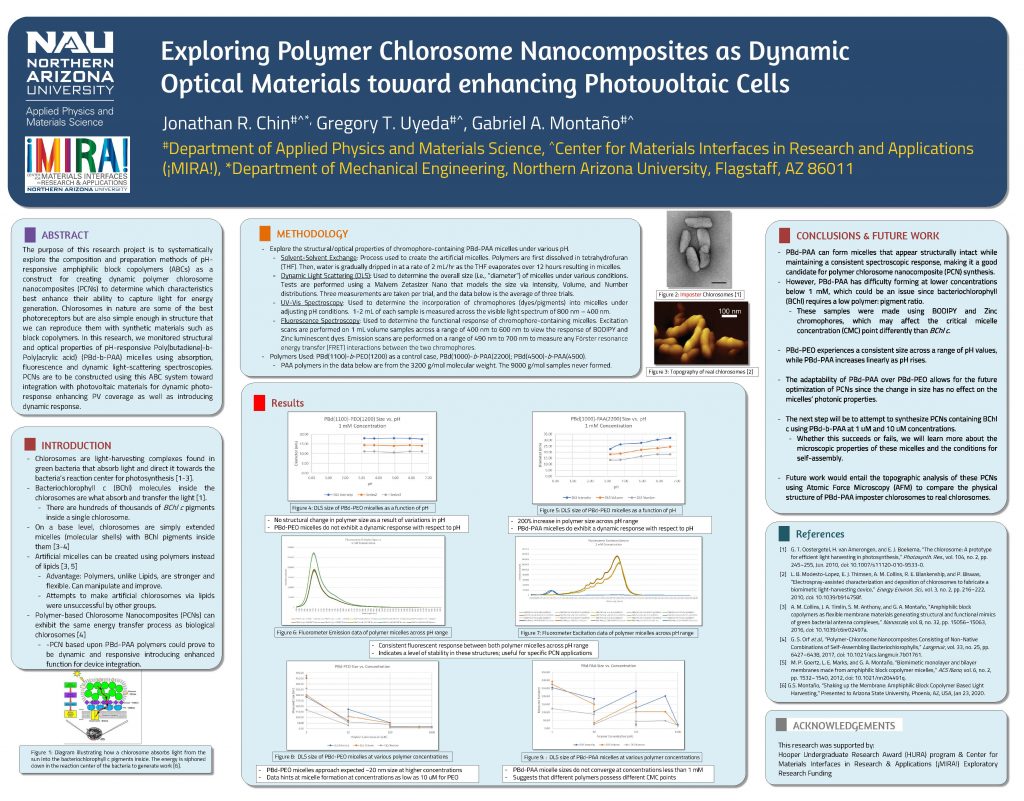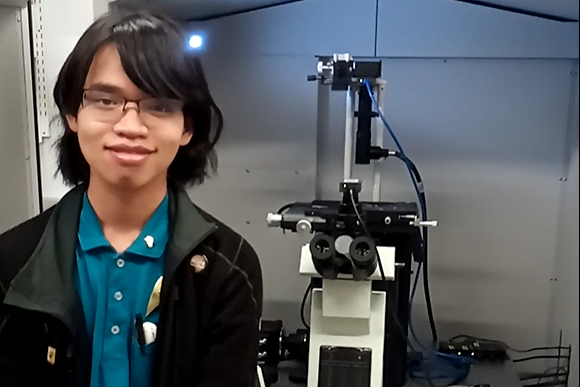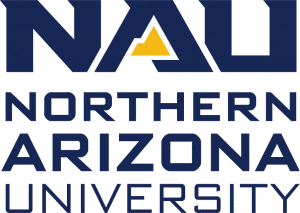Current solar panels capture about 20 percent of the sunlight that hits them. Increasing the efficiency of this technology will mean more renewable energy in the power grid without additional infrastructure.
Researchers at Northern Arizona University are looking for ways to use artificially created chlorosomes to create a more efficient solar panel. One of those researchers is Jonathan Chin, a student from Sunnyvale, California, who graduated in April with degrees in physics and mechanical engineering. His work on this project over the last year led to his selection for this year’s class National Science Foundation’s Graduate Research Fellowship Program (GRFP).
The award, which will fund Chin’s Ph.D. program starting this fall, takes him one step closer to a career in groundbreaking research that will redefine the world’s relationship to energy.
“A lot of energy generation is unsustainable—even if it works now, it won’t later,” Chin said. “I want to join a research community dedicated to creating new kinds of energy so we aren’t caught off guard when we lose access to fossil fuels.”
His love for science started as his parents looked for ways to include diverse representation in his upbringing. He was adopted from Vietnam; his father is second-generation Chinese American, and his mother is both Mexican and Native American; and he grew up in a largely white neighborhood in the Bay Area. Looking for that much multiculturalism elsewhere, the Chins introduced their son to “Star Trek.” He found himself in more than one way.
“Every day for three years, we watched at least one episode of the five ‘Star Trek’ series that existed at the time,” he said. “This experience sparked my love for science and engineering, my main takeaway from the franchise being that most problems can be solved through the clever application of physics. In time, I aspired to the position held by miracle worker Montgomery Scott—captain of engineering.”
He helped out at his father’s engineering company after high school, and after coming to NAU he got involved in undergraduate research, presentations, the Honors College and tutoring. He found internships at engineering firms and took the lead on his engineering capstone project. Somewhere along the way, he realized he wanted to get a doctorate.
Chin found his passion for climate change research after a visit to the Museum of Northern Arizona, where he walked through a photographic exhibit chronicling Flagstaff’s peak snowfall dating back to the 1900s. Seeing the marked decrease in snowfall through the years made the effects of climate change personal. He saw ways science could offer technological solutions that make economic and political sense.
Those goals have defined his research at NAU and the Ph.D. research he’ll take on in the fall.
“My end goal is to have the research be applicable to society at large, or at least contribute to research that would eventually do that,” he said.
Chin’s undergraduate research
Chin’s research started in late 2019 in his physics capstone class when all of Chin’s classmates were discussing the research they’d done. He hadn’t done any, but at a career day shortly after, he struck up a conversation with Gabriel Montaño, who had just started the Center for Materials Interfaces in Research & Applications (¡MIRA!). Just before the pandemic hit, Chin started working on a project to investigate and optimize a method of increasing the amount of light a solar cell can capture by using artificial, polymer-based chlorosomes. While chlorosomes occur nationally, being able to build these molecules will allow scientists to change the size to test for different effectiveness. Using naturally occurring molecules doesn’t allow for that sort of consistency.
Chin earned a Hooper Undergraduate Research Award for this project; he proposed it with the goal of having a working prototype solar panel by April. He encountered a few unexpected challenges along the way, so his project didn’t get as far as he’d planned. But that’s part of the process of science.
“The end goal is to try to enhance light capturing and make solar panels more efficient,” he said. “We’re not anywhere close to that, but we shifted our goal to characterizing the process and understanding what’s happening.”
The hypothesis was simple: In a lab, solar panels capture three times more sunlight than panels outside. Scientists have been unable to replicate those lab results in the real world. Chin’s goal was to create a material that could help increase the amount of light panels could capture, thus generating more energy without changing the overall product. Research on naturally occurring chlorosomes applied to solar panels showed a 30 percent increase in power generation, but no one has studied it using artificially created polymers, which would be feasible to recreate in real-world scenarios.

He still can’t say they’ve landed on the best design, and his research did not provide the conclusive information he set out for when he started. But he and other researchers have more information about these molecules now and are further along in answering the question. That in itself taught Chin an important lesson about his future career.
“The biggest surprise was that everything didn’t work exactly the way I expected it to the first time I did it,” he said. “That’s what I’m used to in classes: you get a problem and solve the equation. Research is not like that. I thought that it would be bad if I wasn’t successful, but it turns out that failure is actually expected in research. It didn’t need to work the first time. I’m allowed and even expected to pivot and redefine my goals.”
“That was the end target of this,” Chin said. “That’ll be for whoever takes up this work later.”
Applying for the GRFP
Applying for this research, which is difficult to get for any graduate student, much less an undergraduate student, was not on Chin’s radar as he started his final year of college. Then, two weeks before the deadline, his mentor suggested he apply. He managed the complete the sizable application in time, relying on the research proposals he’d already written to guide him through.
Jennifer Wade, an assistant professor of mechanical engineering, recommended Chin to the NSF. She’d had him for a couple of classes and saw the curiosity and desire for knowledge that marked a good researcher. He also shared a sense of humor in her thermodynamics class, a rather humorless course otherwise.
“He was one of a handful of students who appreciated my levity when discussing the second law of thermodynamics, the one that describes how the universe always moves in the direction of more disorder,” Wade said. “When you sit on that topic, it’s easy to feel some doom, and he appreciated the depth of what that fundamental law can tell us.”
Chin’s success in that course led to Wade recommending him to be a tutor, as many students struggle to understand the material and pass the class their first time. She observed not only his love of learning but also his ability to share that love and his grasp of the material with fellow students.
The two also talked before or after class, and he told her about the research he did with Montaño and his interest in materials science, which Wade also taught. As an alumna of the GRFP program, she figured he would be competitive in this elite program and advised him through the application process.
He was also a student in her Experimental Methods course in fall 2020 and was one of the few students who came in person.
“I got to witness his excellence in being a team player with his other two classmates while conducting lab experiments in a mixed in-person/remote mode over Microsoft Teams,” she said. “It was like watching a team of engineers out of a Star Trek movie operating a critical mission. I only wish those moments were recorded.”
What’s next
Throughout the summer, Chin will continue to work with Montaño’s research team; the data showed trends that are consistent enough to published in a scientific journal, even if it didn’t do what he expected it to. In the fall, he’ll start a Ph.D. program at Georgia Tech. While there, he will be working on ferroelectric materials; these are a subset of piezoelectrics, which are materials that generate a voltage when a researcher applies stress. With no battery, the material can send a current to whatever it’s attached to. Ferroelectrics are known as a smart material because these properties change based on the stimuli.
In the lab at Georgia Tech he’ll be growing the crystalline structures needed to get ferroelectric materials to work. It’s a new type of research, as the technology necessary to use the materials hasn’t existed before.
“There’s some research that suggests that we can use these to create a new type of solar cell,” Chin said. “I’m always looking into new green energy stuff, and this is one avenue where it’s theorized that by taking light, with its own electric response, we can create ferroelectrics that can use that light and harvest its energy in a different way than existing solar cells.”
Editor’s note: Six NAU students were selected for the National Science Foundation’s Graduate Research Fellowship Program. Read about their research.
Megan Gialluca: Dark matter amid the dark skies: In four years at NAU, research takes grad to the ends of the universe
Jessica Archibald: Managing mangroves: GRFP recipient Jessica Archibald studies social-ecological approaches to forest restoration
Ethan Taber: Two years after Museum Fire, NAU grad student looks at what slow regeneration of fire site could mean for the future
Heidi Toth | NAU Communications
(928) 523-8737 | heidi.toth@nau.edu




